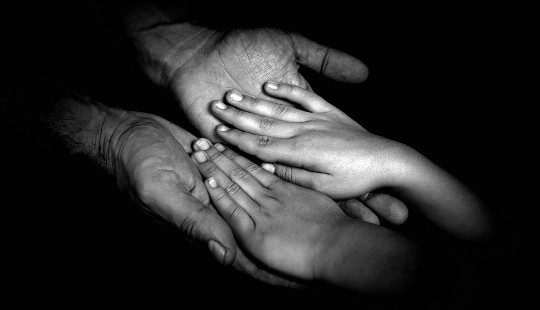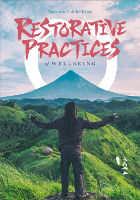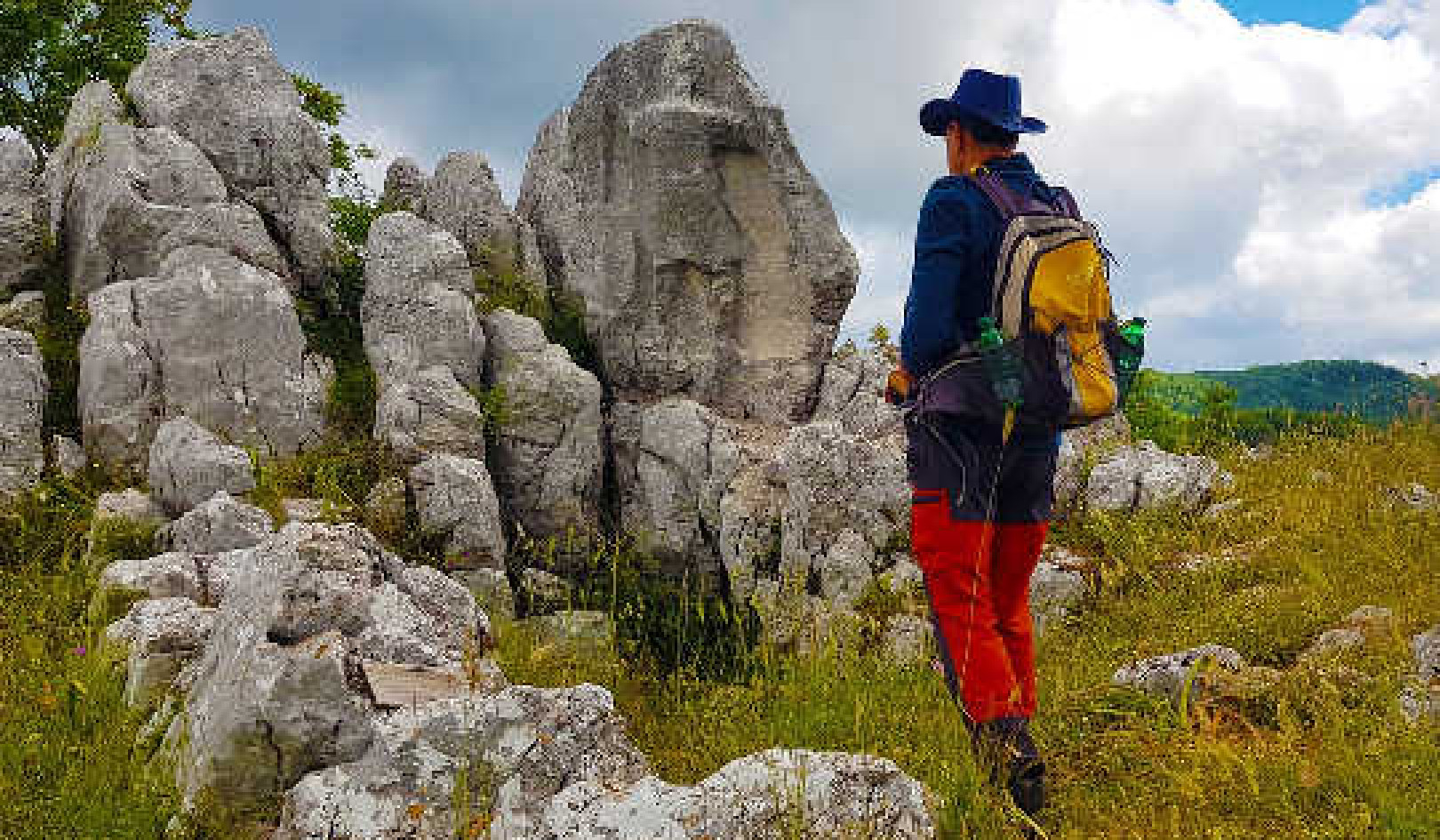
Image by Architect and artist.
Narrated by Marie T. Russell.
Watch video version at InnerSelf or on YouTube
For 99.9% of human history, the way we lived was all about connection. What our hunter-gatherer ancestors prioritized above all things was our connection to ourselves, one another, and the Living World.
At a biological level, a connection system is built into every human being. This biological system wires together the neural regulation of the face and voice with the heart and breath. When we feel safe, it brings us into physiological regulation and attuned relationships with others. This connection system is, biologically, the root of health and well-being.
Can you sense it? When this circuit is online, you feel well. But what if it’s offline?
Bringing this system online used to be the job of our culture. Culture is, through one lens, a set of practices that contain neural exercises for teaching humans how to connect. As transdisciplinary psychology researcher Darcia Narvaez, Ph.D., explains:
When a culture operates from this baseline, its people exhibit moral behavior. They have a sense of being connected to something larger than themselves. They display high levels of physical, emotional, mental, and spiritual health. They exist in a harmonious relationship with the Living World.
Yet if you take one look at modern society, it’s painfully apparent that we’re completely failing across every one of these domains—so catastrophically, in fact, that it threatens to undermine the integrity of the terrestrial biosphere (if we don’t kill each other first).
So how can we bring our connection circuits online if our culture is actively working against us?
1. Start with safety and downshifting distress
The key to turning on our biological connection system is a sense of safety; we must feel safe before we can do anything more. Take this in, because we live in a culture that inequitably distributes safety. We’ve taken this basic human right and turned it into a privilege, one that those who possess it take for granted so deeply that they don’t know it’s the foundation of their own well-being.
To have access to safe drinking water, to have enough food, to live in a neighborhood where you’re not afraid you’ll be shot: these are rights that have become privileges in our highly unequal society. To be able to walk down the street without being aggressed or microaggressed because of your gender, race, or religious beliefs. For many of us, safety was never promised.
And so, we must start by nurturing felt experiences of safety, both alone and in community. What does it feel like, in your body, when you feel safe?
If you don’t feel safe, you must downshift your body’s response to threatening experiences before you can be open to connection.
2. Map your connections
Since connection is the foundation of our health and happiness, we should ask ourselves: “What am I connected to? And to whom?”
When you know what you’re connected to, you have a map of the sources that will give rise to your well-being. It’s a map of what Buddhist monk Thích Nh?t H?nh called interbeing.
When modern people begin to map their connections, many realize they aren’t spending enough time, attention, or care nourishing them. Let’s change that. As our mentor John Stokes, founder of The Tracking Project, reminds us, “What we don’t talk to, we don’t understand. What we don’t understand, we fear. What we fear, we destroy.” Turning this around is as simple as learning to talk with—and connect with—the life that surrounds us and then noticing how we feel when we do.
3. Nourish your connections
Once you begin to see a map of your connections, focus on strengthening those that matter. We nourish connections with our attention, and as they’re nourished, these relationships grow stronger.
The San bushmen of South Africa’s Kalahari Desert call this process “building ropes.” The San culture is the oldest continuous culture in the world, with an oral history that tracks back more than 100,000 years. Those still living in these ancestral hunter-gatherer lifeways are masters of deep nature connection.
The San bushmen say that when a person goes out into nature and recognizes an individual animal, a tiny energetic thread forms between the two beings as a result of this “true seeing.” The South African Zulu word sawubona reflects this awareness. Each further recognition strengthens the thread: soon it becomes a cord, then a rope.
They say that to be a bushman is to create ropes with all of creation. We should all make it a practice to build our own ropes.
4. Make it a daily practice
We need to nourish our connections every day, particularly at a moment when humanity has crawled out from a two-year “connection fast” and looming threats surround us. Micro-moments of connection—seeing someone smile, giving or getting a hug or a pat on the shoulder—these moments of reciprocity and relationship are nourishment for our body’s connection system.
When these moments of connection are lacking because we can’t see one another’s faces or be touched by our friends, our nervous systems drift toward defense: fight, flight, and shutdown. Because our nervous systems were designed to respond to threats, we drift gravitationally toward stress. To avoid this, we must fortify our connections.
Make it a practice to feed yourself connection daily. We can seek and sustain connection with others through mindful movement, meditation, prayer, practicing solidarity, soldiering peace, working with our hands, playing an instrument, playing with a pet, smiling a lot, expressing gratitude, engaging in creative practice, or spending time in nature. Connection arises when we’re sincere. Examine what you’re connected to and practice nourishing those connections with regularity.
5. In a pinch, hack your connection system
At a physiological level, stimulating the ventral vagal aspect of your autonomic nervous system can “hack” into your connection system. These aren’t really things you’d do for pleasure, but they’re mechanical ways of shifting your system from “off” to “on” that can reset your connection system.
Dip your face in cold water.
Try it. Your next breath will be different.
Stick out your tongue.
Use the tip of the tongue as a probing tool: Touch your chin with it. Reach it out and wiggle it. Imagine that the tip of your tongue is connected, through sensation, all the way to the tips of your toes. See if you can probe and trace the path between your tongue and your gut. This is important: reestablishing the tongue-gut connection is at the core of this exercise; it’s what elicits the state shift.
Induce the vomiting reflex.
Do you remember how, after you throw up, you always feel so much better? Is that because you’ve cleared something toxic, or because vomiting itself tones your ventral vagal system? I like to envision letting go of whatever is stuck inside me that I don’t need. It’s OK if you actually throw up. In many ceremonies, this is called “getting well.”
Bear down as if having a bowel movement.
You don’t have to do this sitting on the toilet, but you can. In this case, you are simply mechanically stimulating that reflex.
Feel your feet on the ground.
Particularly when people feel anxious, they often lose contact with the sensations of their feet on the ground. Most shoes don’t help because we can’t feel the ground through them. Going barefoot, wearing slippers, or wearing barefoot shoes can restore our contact with the ground, putting us back into touch with a more primal sense of vitality and helping us come back into our bodies.
Let your body move.
Once you feel the ground and find your breath, let your body move as it wishes. Let it run. Let it unwind. See if you can stop restricting the way it responds.
Our bodies naturally send us gifts of regulation if we stop suppressing them. Our socialization often inhibits us from accessing the resources our bodies send us through movement and facial expression. Let go. None of us are in control anyway.
Copyright 2022. All Rights Reserved.
Book by this Author:
Restorative Practices of Wellbeing
Restorative Practices of Wellbeing
by Natureza Gabriel Kram. In this pioneering volume, connection phenomenologist Gabriel Kram addresses two fundamental practical questions: how do we address the trauma and disconnection endemic to the modern world, and how do we turn on the Connection System? Marrying cutting-edge neurophysiology with awareness technologies from a wide variety of traditions and lineages, this book maps a novel approach to the creation of wellbeing informed by the most cutting-edge science, and the most ancient of awareness practices. It teaches over 300 restorative practices of wellbeing to connect with Self, Others, and the Living World.
In this pioneering volume, connection phenomenologist Gabriel Kram addresses two fundamental practical questions: how do we address the trauma and disconnection endemic to the modern world, and how do we turn on the Connection System? Marrying cutting-edge neurophysiology with awareness technologies from a wide variety of traditions and lineages, this book maps a novel approach to the creation of wellbeing informed by the most cutting-edge science, and the most ancient of awareness practices. It teaches over 300 restorative practices of wellbeing to connect with Self, Others, and the Living World.
For anyone who has faced a difficult childhood, grown up with a sense that there is something missing in the modern world, or yearns for deeper connection with Self, Others, or the Living World, this book provides a map to a (r)evolutionary approach to wellbeing so ancient it hasn't been invented yet.
For more info and/or to order this book, click here.
About the Author
 Natureza Gabriel Kram is a connection phenomenologist. Over the past 25 years, he’s undertaken advanced study and research in neurophysiology, applied mindfulness, social justice pedagogy, deep nature connection, cultural linguistics, and Indigenous lifeways with support from over 50 mentors in 25 disciplines of well-being from 20 cultures. He is convener of the Restorative Practices Alliance, founder and CEO of Applied Mindfulness, Inc., and co-founder of the Academy of Applied Social Medicine.
Natureza Gabriel Kram is a connection phenomenologist. Over the past 25 years, he’s undertaken advanced study and research in neurophysiology, applied mindfulness, social justice pedagogy, deep nature connection, cultural linguistics, and Indigenous lifeways with support from over 50 mentors in 25 disciplines of well-being from 20 cultures. He is convener of the Restorative Practices Alliance, founder and CEO of Applied Mindfulness, Inc., and co-founder of the Academy of Applied Social Medicine.
He is the author of several books, including Restorative Practices of Wellbeing, an interactive compendium of over 300 practices that restore wholeness and well-being. Learn more at restorativepractices.com/books.



























